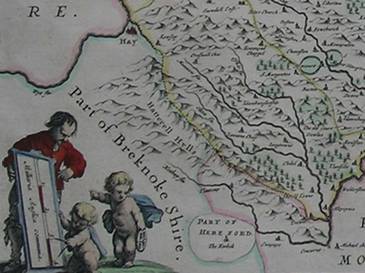Held at: | Private collection |
Reference: | gc |
Source: | research |
Title: | Newcourt and Bacton Manor Estates |
Place name: | Bacton, St Margarets, Newton, Golden Valley |
Date: | 1200 -1912 |
Description:
The earliest maps of the County of Herefordshire; those based upon Saxton’s map of 1577, show an enclosed paled Deer Park at Newcourt. The Park is extensive, it stretches from the low wet lands of the River Dore on its east, across the higher wooded ground to the parishes of St Margarets and Newton in the west. The one time existence of the Deer park is also evidenced by surviving place names such as: Park Farm, Park Wood, The Maerdy (house of the Steward), Grange, Lower Grange, The Lawns, and Lawns Wood, these are all indicative of the Deer Park.
At Newcourt behind and above the present Farmhouse are the remains of a small motte and bailey Castle which probably dates to the late 12th or mid 13th century. William de Bacton held a knight’s fee here in 1166 and is possibly the builder and original holder of the Castle and what was to become the Newcourt Estate. The existing Newcourt farmhouse has no special significance and was probably built in the late 1800’s; it is in the style of other Bacton estate properties.
|
|
| From map Of Joannes Jansson 1646 |
In the 16th century Newcourt had descended to the interrelated families of Vaughans, Whitneys and Parrys. The most famous of which was Blanch Parry, c1507 – 1590. Blanch was born at Newcourt and became an attendant on the child Elizabeth who was to become Elizabeth l Queen of England. She stayed with Elizabeth, became her Maid of Honour, and keeper of her jewels and books. Blanche died in 1590 and is buried in St Margarets Church in Westminster with a memorial effigy in Bacton Church. In her will Blanch remembered the poor of Bacton and Newton and founded a Charity for their care.
Another with connections with Newcourt was Rowland Vaughan of Newcourt and Whitehouse in adjoining Turnastone. The Whitehouse estate had strong connections with Newcourt and was probably an off shoot or daughter estate of Newcourt.
By the early 19th century the original demise house of Newcourt had fallen into disuse and its replacement was built lower down the valley but still on Newcourt property. This became known as Bacton Manor and the estate as the Bacton Estate. William Henry Hamp was the owner occupier of Bacton Manor in the mid 19th century. He was active in local matters and one of the key founders of the Dore Workhouse on nearby land. The Workhouse is now converted into housing and known as Riverdale.
By the 1870’s William Laslett, Esq., of Abberton Hall, Pershore, was Lord of the Manor and the principal landowner of Bacton. William Laslett was a Worcester Lawyer and reputed to be one of the wealthiest commoners of England. In his will he gave the Bacton Estate together with Morehampton Park to Lieut. Colonel Robert Bridges Bellers of Grove Villa in the City of Worcester who inherited in the 1880’s. The 1901 census of Bacton give the residents of Bacton Manor as the 77 year old Colonel now a widower, together with a 43 year old daughter Constance and two servants. Colonel Bellers died in 1903 and the property reverted to the Partridges.
A daughter of William Hamp, Mary Frances Elizabeth Hamp was born at Bacton Manor, educated at Clifton College and in 1871 married William Bailey Partridge of Llanddewi Court Monmouthshire. She was 17 and he 31. The Partridges were a South Wales family with financial Interests in mining and railways. They built a new house on the Green Farm; this house was initially called The Green but later became Bacton Stud . They had at least 3 sons and 2 daughters. One son Reginald was killed in the South African war and the eldest Richard Crawshaw Bailey Partridge, who became Lord of the Manor following his fathers death in 1909, was killed in the first World War on 28th September 1918. A gateway was erected as a memorial to him at Dore Abbey.
Following the two deaths within a 10 year period the Partridges found it necessary to sell off a large part of their property. So in May 1919 a two day sale by auction was held in Hereford. On the first day the major portion of the Bacton Estate was sold and on the second day properties which the Partridges had added in Abbey Dore and also Llanfoist House near Abergavenny came under the hammer. The Partridges retained some parts of the Bacton estate mainly the main house ‘The Green’ and also lands by Bacton Church and also the Upper Grange which became a dower house.
Mary Partridge continued to live at The Green. It became a stud farm and she bred race horses with some success. In 1927 one of her horses called Sprig won the Grand National. It was a day remembered in the area.
For details of the Sale Particulars of the Bacton Estate, click here
To see all documents relating to Bacton Manor, click here
To see all documents relating to Bacton Estate, click here
For the fortunes and misfortunes of the Hamp family of Bacton Manor, click here
Observations:
none
Ref: gc_gdv_2126

